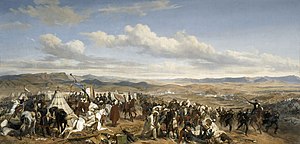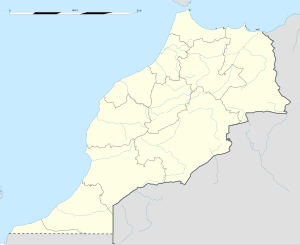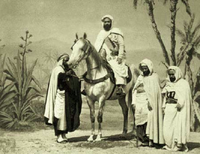Battle of Isly
| Battle of Isly | |||||||
|---|---|---|---|---|---|---|---|
| Part of the Franco-Moroccan War | |||||||
 Battle of Isly, oil painting by Horace Vernet. | |||||||
| |||||||
| Belligerents | |||||||
|
|
| ||||||
| Commanders and leaders | |||||||
|
|
| ||||||
| Strength | |||||||
| 10,400 soldiers[1] | 45,000 soldiers[1] | ||||||
| Casualties and losses | |||||||
|
27 killed 99 wounded[2] |
800 killed 1,500 wounded[1] 11 artillery | ||||||
Location of the Battle of Isly | |||||||
The Battle of Isly (Arabic: معركة إيسلي) was fought on August 14, 1844, between France and Morocco, near the Isly River. French forces under Marshal Thomas Robert Bugeaud routed a much larger, but poorly organized, Moroccan force, mainly fighters from the tribes of Beni Snassen, but also from the Beni Angad and Beni Oukil;[3] under Muhammad, son of the Sultan of Morocco, Abd al-Rahman. Bugeaud, attempting to complete the French conquest of Algeria, instigated the battle without a declaration of war in order to force negotiations concerning Moroccan support for the Algerian resistance leader Abd el-Kader to conclude on terms favorable to the French[4] who demanded the Sultan of Morocco to withdraw support for Abd el-Kader.[5]
Bugeaud, who recovered the Moroccan commander's tent and umbrella (equivalent to capturing a military standard in European warfare), was made Duke of Isly for his victory.
The day following the battle, the Bombardment of Mogador started.[6]
Background
[edit]Since the Invasion of Algiers in 1830, Emir Abd el-Kader had taken lead of the tribes of the region of Mascara to oppose the French in 1832. A first treaty, signed by General Desmichels in 1834, was deemed too favorable to him. in 1837, Marshal Bugeaud was therefore instructed to sign a new one, the Treaty of Tafna, which required Abd el-Kader to recognize the sovereignty of France in North Africa, in exchange for which France recognized the authority of Abd el-Kader over a large part of Algeria; the whole Beylik of Oran (with the exception of the cities of Oran, Arzew, Mostaganem and Mazagran), the Beylik of Titteri and the Beylik of Algiers (with the exception of the cities of Algiers and Blida), as well as the plain of Mitidja and the Algerian Sahel.[7]
The Sultan of Morocco Abd al-Rahman attempted seizing Tlemcen from the French in October 1830. The Sultan sent 5,000 cavalry and infantry. Moroccan soldiers rampaged through the streets of Tlemcen, looting and fighting. The Sultan eventually had to retreat them.[8]
Nevertheless, Abd el-Kader never turned down his will to drive the French out of Algeria. To this end, he requested and obtained the support of the Sultan of Morocco Abd al-Rahman, in which in theory he was a vassal of the Moroccan sultan,[9] as well as the concession of the territory located between Oujda and the Tafna River. Abd el-Kader had raised a real army, and in November 1839, supported by the Sultan of Morocco Abd al-Rahman, he declared war on France, following the crossing of the Bibans (Iron Gates) by the French army.[10]
In reaction, the French then truly undertook the systematic conquest of the country, which the July monarchy made a reason for national pride and military heroism. This conquest was the work of Marshal Bugeaud, appointed governor in 1840. Abd el-Kader saw his capital destroyed in Taguin in 1843 following the Battle of the Smala and was driven back into the desert. He then took refuge in Morocco, but, at the same time, the army of Sultan Abd al-Rahman was defeated at Isly, while the French fleet bombarded the ports of Tangier and Mogador. After three years of guerrilla warfare, Abd el-Kader surrendered to Lamoricière in 1847.[11]
Prelude
[edit]On 30 May, French troops of General Bedeau had to repel a Moroccan attack.[12] The Moroccan Qaid crossed the border into Lalla Maghnia, a place sixty kilometres from Tlemcen, and attacked the French camp with his Moroccan cavalry.[12] The attack was soon repulsed by General Lamoricière. The next day Marshal Bugeaud embarked at Algiers.[12] On 15 June, Moroccan troops fired upon French troops, wounding Captain Daumas and two men, demanding that the border must be set back to the Tafna River. On the 19th, French troops occupied Oujda.[12]
Battle
[edit]On 6 August, Tangier had been bombarded by French ships commanded by François d'Orléans, a son of the King of France, Louis Phillippe I.[13]
The Governor General having assembled all his forces, made up of 11,000 men, marched on the Moroccan camp established at Djarf el-Akhdar, a short distance from Oujda, on the right bank of the Isly River, a sub-tributary of the Tafna River.[4]
Having to deal almost exclusively with cavalry, he had formed from his infantry a large diamond whose faces were themselves made up of small squares. The cavalry was in the interior of the lozenge which marched through one of its angles duly provided with artillery.[14]
At daybreak, seeing the French army advance, the Sultan sent the Moroccan cavalry with a mass of 20,000 to 25,000 cavalry. This charge did not succeed in forcing the lines of tirailleurs, and was soon separated in two by the squares of the advancing cavalry. Bugeaud then brought out his cavalry. This formed by echelons, charged the Moroccan cavalry which was to the left of the army and dispersed it after having defeated several hundred of its cavalry. The first echelon, composed of six squadrons of spahis commanded by Colonel Joseph, rushed to a Moroccan camp and captured eleven pieces of artillery. The Moroccan artillerymen did not have time to reload.[15]
The Moroccan infantry dispersed in ravines where the French cavalry could not pursue them. While the first echelon marched on the camp, the second commanded by Colonel Morris moved on the part of the Moroccan cavalry which was on the right. It was a difficult endeavor. After it was over, the French army concentrated on the Moroccan camp, and soon set out in pursuit to prevent them from rallying.[14][16]
Consequences
[edit]As a result of the battle, the French captured eleven pieces of artillery, eighteen flags, and all the Moroccan tents. The Moroccans had 800 of their men killed when the French had 27 of their men killed and 99 of them wounded.[15]
References
[edit]- ^ a b c Clodfelter, M. (2017). Warfare and Armed Conflicts: A Statistical Encyclopedia of Casualty and Other Figures, 1492-2015 (4th ed.). Jefferson, North Carolina: McFarland. p. 199. ISBN 978-0-7864-7470-7.
- ^ Pierre Montagnon, The conquest of Algeria: The seeds of discordie, 2012.
- ^ "La bataille d'Isly, ou l'engagement constant du Maroc envers le Maghreb". Sahara Question. 13 August 2020. Archived from the original on 26 October 2020.
- ^ a b Hekking, Morgan. "The Battle of Isly: Remembering Morocco's Solidarity With Algeria". Morocco World News. Archived from the original on 22 September 2020. Retrieved 11 August 2021.
- ^ Churchill, Charles Henry (1867). The Life of Abdel Kader, Ex-sultan of the Arabs of Algeria: Written from His Own Dictation, and Comp. from Other Authentic Sources. Chapman and Hall. p. 236.
- ^ E.J. Brill's First Encyclopaedia of Islam 1913-1936. BRILL. 1987. p. 550. ISBN 978-90-04-08265-6.
- ^ "Battle of Isly | Algerian-French history". Encyclopedia Britannica. Retrieved 11 August 2021.
- ^ Miller, Susan Gilson (15 April 2013). A History of Modern Morocco. Cambridge University Press. p. 14. ISBN 978-0-521-81070-8.
- ^ Miller, Susan Gilson (15 April 2013). A History of Modern Morocco. Cambridge University Press. p. 15. ISBN 978-0-521-81070-8.
'Abd al-Qadir was careful, however, not to appear to challenge 'Abd al-Rahman's own claims of suzerainty, and made it known that he was acting merely as the Moroccan sultan's khalifa, or deputy. Still in theory a vassal of the Moroccan sultan
- ^ Nodier, Charles (2004). Journal de l'expédition des portes de fer (in French). SERRE EDITEUR. p. 319. ISBN 978-2-906431-76-8.
- ^ "La bataille d'Isly | Histoire et analyse d'images et oeuvres". histoire-image.org (in French). Retrieved 11 August 2021.
- ^ a b c d d'.), Henri Amédée Lelorgne Ideville (comte (1884). Memoirs of marshal Bugeaud, from his private correspondence and original documents, 1784-1849, ed. from the Fr. by C.M. Yonge. pp. 112–118.
- ^ Sondhaus, Lawrence (4 May 2004). Navies in Modern World History. Reaktion Books. p. 71. ISBN 978-1-86189-202-7.
- ^ a b Terrasse, Henri (1952). History of Morocco. Éditions Atlantides. p. 148.
- ^ a b Pennell, C. R. (2000). Morocco Since 1830: A History. C. Hurst & Co. Publishers. p. 49. ISBN 978-1-85065-426-1.
- ^ Wagner, Moritz (1854). The Tricolor on the Atlas: Or, Algeria and the French Conquest. T. Nelson and sons.


